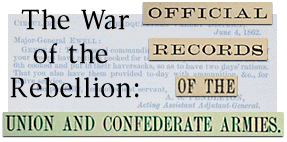Summary:
General Jacob Cox commanded Union forces in the Kanawha Valley in what is now
West Virginia during the spring of 1862. In this March letter, he informs
General John C. Fremont of the situation in his sector, including troop
strengths and enemy positions. The importance of Staunton as a rail center
becomes evident when Cox mentions the frequent fluctuation of Confederate
strength at Jackson Station, linked by rail to Staunton, VA.
Maj. Gen. J. C. FREMONT, Wheeling:
CHARLESTON,
March 31, 1862.
My latest information is that only a small force of 400 or 500 men hold Lewisburg, and these are ordered to collect the cattle of that vicinity and drive them to Jackson River Station, and to burn the forage in Greenbrier County which they cannot carry off. Some force is reported at Jackson Station, but nothing definite. From its railroad connection with Staunton the number of troops there is variable, according to apparent exigencies. The roads are rapidly settling now, and a week of good weather will make them tolerably good, except at the extremities, where they have been constantly used during the winter.
On the Newbern and Wytheville roads my reports are as follows. At mouth of Blue Stone, 250 men; at 3 miles up Blue Stone, 200 men and one iron 6-pounder; both camps with breastworks and abatis. On Flat Top Mountain French's company of cavalry, and a few cavalry and infantry at Princeton. These are manifestly mere posts of observation and will make no serious resistance.
At Newbern it is supposed the forces in that vicinity, with such re-enforcements as can be spared from Lynchburg, will be concentrated with a view to hold the railroad. The road from Gauley Bridge to Raleigh is bad; from Raleigh to Gladesville pretty good; from Gladesville to Wytheville it is very rough, and broken in places by land slides and passes through very hard defiles, but from Gladesville, via Princeton and Pearisburg, to Newbern it is reported passable.
Humphrey Marshall is reported to have concentrated his troops at Moccasin Gap, northwest of Abingdon. I cannot learn his number, but suppose them to be about 2,000.
I greatly regretted to hear of Gen. Garfield's removal from Eastern Kentucky. He is one of our best officers and was very desirous of serving under your command. I do not believe the rebels have 5,000 men under arms from Abingdon to Lewisburg. If the roads get once well settled I am confident the Lewisburg and Newbern routes can both be used by pretty heavy columns.
Both Gauley Bridge and Fayette Court-House are safe depots now for stores, and as the roads this side of those places are the worst, I suggest the accumulation of supplies there at an early day. Sibley tents are the only ones we have except a few common tents, and not over two-thirds of the command are supplied with any.
Not knowing who is your adjutant-general, I address you directly, and am most happy to report to you for orders.
J. D. COX,
Brig.-Gen. Comdg. District of the Kanawha.
Bibliographic Information : Letter Reproduced from The War of The Rebellion: Official Records of the Union and Confederate Armies, Series 1, Volume 12, Serial No. 18, Pages 35-36, Broadfoot Publishing Company, Wilmington, NC, 1997.

